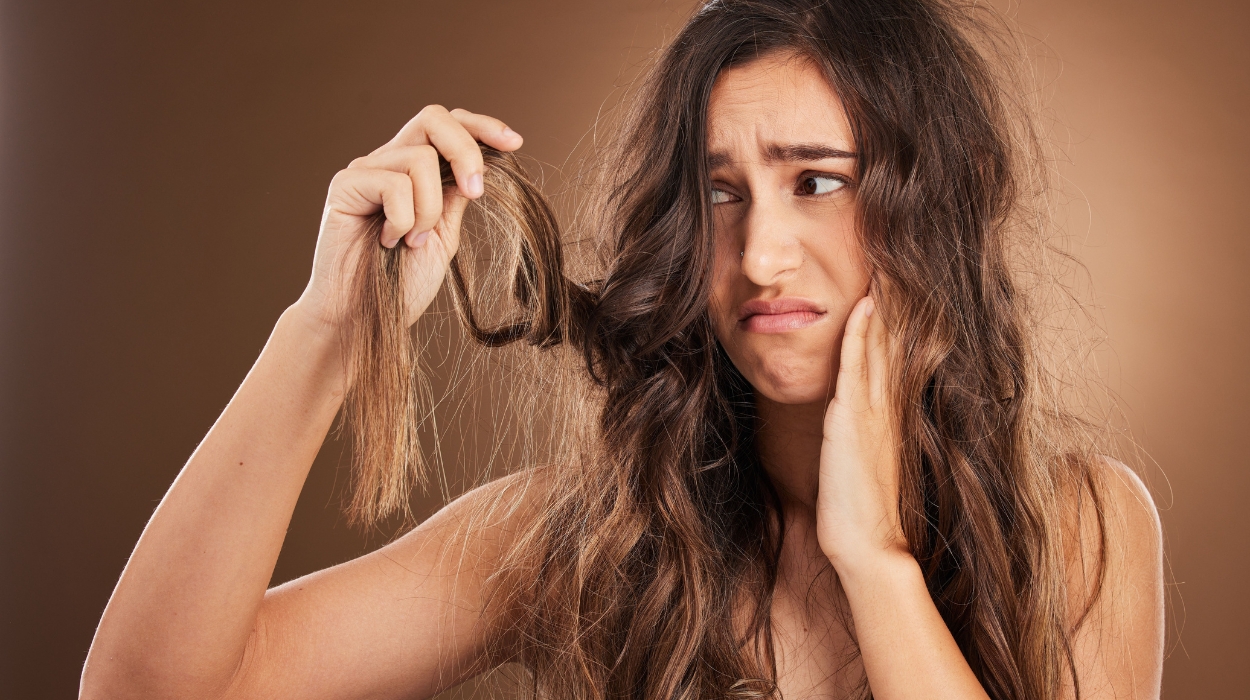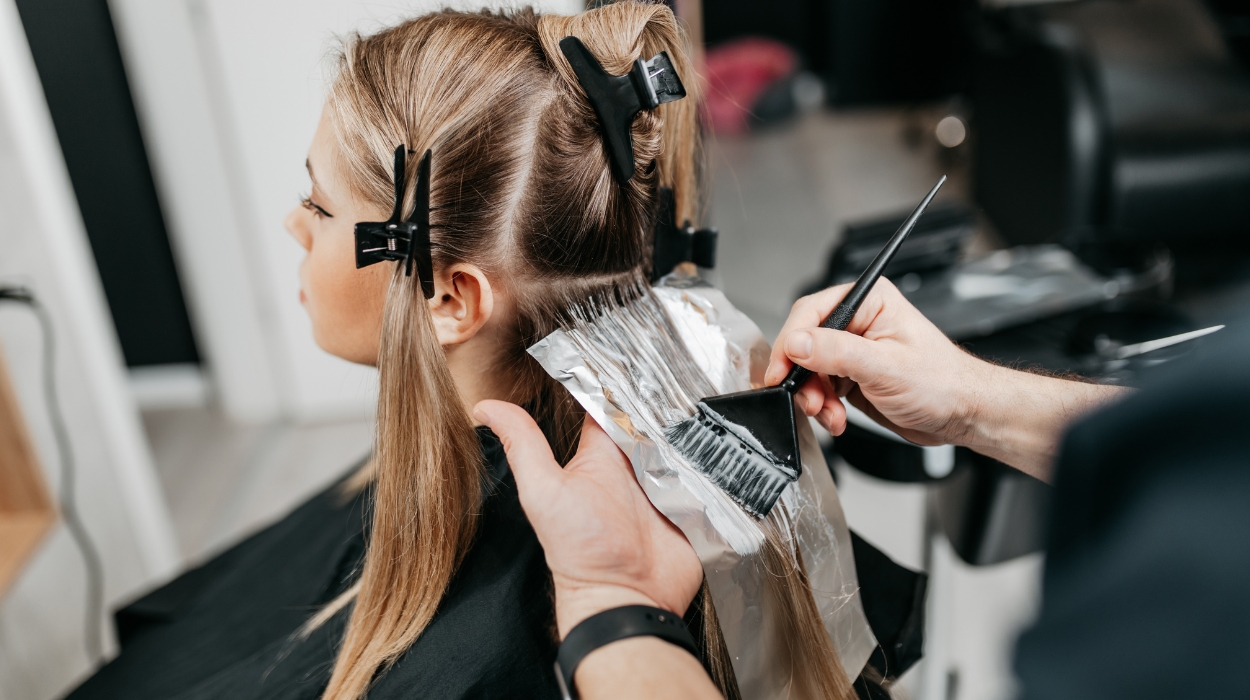 Expert's opinion
Expert's opinion
Expert's opinion
The article is a subjective view on this topic written by writers specializing in medical writing.
It may reflect on a personal journey surrounding struggles with an illness or medical condition, involve product comparisons, diet considerations, or other health-related opinions.
Although the view is entirely that of the writer, it is based on academic experiences and scientific research they have conducted; it is fact-checked by a team of degreed medical experts, and validated by sources attached to the article.
The numbers in parenthesis (1,2,3) will take you to clickable links to related scientific papers.
Hair Breakage: A Complete Guide To Make Hair Healthy In 2024

Throughout our lives, our hair grows and dies — making room for new hair to take its place. It’s a fascinating process involving a continuous growth cycle, rest, and shedding cycle. However, when hair becomes weak and brittle, it’s prone to hair breakage, which can be a frustrating and disheartening experience — especially when we try to maintain it with good practices and superfoods for hair.
Hair breakage can be caused by various factors, such as harsh chemical treatments, heat styling, and even improper hair care routines. But don’t worry; here, we’ll address everything you need to know about hair breakage, from understanding its causes to effective solutions.
Key Takeaways
- Hair breaking can be caused by various factors such as excessive heat styling, chemical treatments, improper hair care practices, and more.
- Experts recommend trimming regularly, minimizing heat styling, being gentle with wet hair, using conditioner and hair breakage products, avoiding harsh chemicals, maintaining a balanced diet, and considering supplements.
What Does Hair Breakage Look Like?
Hair breakage is when hair becomes weak and brittle, leading to strands breaking off the shaft. It occurs when the structural integrity of the hair strand is compromised, leading to its fracture or snapping. To understand the science behind hair breakage, let’s delve into the anatomy of a hair strand.
Hair is a complicated structure consisting of the hair follicle and shaft. The hair follicle is where your hair begins to grow and is held in place. It’s a stocking-like structure that starts in the epidermis, your skin’s top layer. It extends to the dermis, your second layer of skin.
At the bottom of the follicle, a piece of tissue called the papilla contains tiny blood vessels or capillaries. These nourish the hair root to keep it growing. The strand also includes the germinal matrix, where cells produce new hairs. When the process of hair growth[1] is disrupted, it can lead to hair breakage.
What Causes Hair Breakage?
Aside from asking, “What is hair breakage?” we often wonder what causes it. If you look deeper, the cause of your hair breakage might be minor. Here are some common causes of hair breakage:
Nutritional Deficiencies
A diet lacking essential nutrients[2] like proteins, vitamins, especially B vitamins and vitamin D, and minerals such as iron and zinc. A deficiency in omega-3 fatty acids[3] can weaken the hair, making it more prone to breakage.
Stress

Chronic or excessive stress can hurt hair health.[4] Stress triggers a hormonal response in the body that can disrupt the hair growth cycle, leading to increased shedding, hair damage, or hair loss.
Additionally, stress can contribute to unhealthy habits such as poor diet, inadequate sleep, and excessive hair pulling or twisting, further contributing to hair breakage.
Hormonal Imbalances
Conditions like thyroid issues or polycystic ovary syndrome can cause hormonal imbalances that lead to hair breakage.[5]
Health Conditions
Some types of hair breakage may be due to health conditions. For instance, hair breakage at the crown is common in conditions like alopecia[6] — an immune system disease that attacks hair follicles and causes hair loss. Furthermore, treating diseases like cancer may cause hair breakage and loss as a side effect.
Chemical Treatments
Excessive use of harsh chemical treatments like relaxers, perms, and hair dye[7] can weaken the hair structure, making it more susceptible to breakage. Chemical treatments like chemotherapy may also cause hair damage and hair loss.
Mechanical Stress
Overbrushing, tight hairstyles, and rough handling of hair can cause physical damage to hair strands, leading to breakage.[8]
Environmental Factors
Exposure to harsh weather conditions, such as sun, wind, and cold, can cause hair to become dry and brittle, increasing the risk of breakage.
Lack Of Moisture
Dry hair is more prone to breakage. Factors like overwashing, harsh shampoos, and inadequate conditioning treatments can strip hair of its natural oils, leading to dryness and breakage.
Poor Hair Care Routine
Harsh hair products, such as shampoos containing sulfates or alcohol,[9] can strip the hair of its natural oils and make it more susceptible to breakage. Overwashing[10] or not washing the hair enough can also affect its health. Additionally, using cotton pillowcases or rough towels to dry the hair can cause friction and breakage.
Signs Of Hair Breakage
Recognizing the signs of hair breakage can help you take action to prevent further damage. Here are some common signs of hair breakage:
- Split ends: When your hair strands are split into two or more parts at the tip, the hair is weak and prone to breakage.
- Increased shedding: While some hair shedding is normal, excessive hair loss when you brush or wash your hair can be a sign of hair breakage.
- Uneven hair length: If your hair has uneven lengths or appears thinner in certain areas, this could be a sign of breakage.
- Dry and brittle texture: Hair that feels dry, rough, and brittle to the touch is more susceptible to breakage. If your hair lacks moisture and elasticity and feels more prone to breakage, it indicates its structural integrity has been compromised.
- Lack of elasticity: Healthy hair is elastic and can stretch without breaking. If your hair snaps easily when pulled or stretched, it’s a sign it’s damaged.
- Frizz and flyaways: Excessive frizz and flyaways can signify damaged hair that’s more prone to breakage.
How To Treat Hair Breakage – Experts’ Advice
Hair breakage can frustrate and dampen our confidence. That’s why we search for long-term solutions. However, no treatment to fix hair breakage has already happened. Instead, we can treat the scalp to avoid more hair breakage.
Generally, treatment for hair breakage[10] requires a combination of effective hair care practices and treatments. Here are some expert-recommended tips to help repair and prevent future hair breakage:
Trim Regularly
Getting regular trims helps to remove split ends and prevent them from traveling up the hair shaft, reducing the risk of breakage. Aim for a trim every 6-8 weeks or as your hairstylist recommends.
Minimize Heat Styling
Excessive use of heat-styling tools can weaken the hair and contribute to breakage. Limit the use of flat irons, curling irons, and blow dryers, and always use a heat protectant spray before applying heat to your wet hair.
Use Conditioner
Conditioning is a certified hair breakage repair method. It helps to hydrate and nourish the hair, making it more resistant to breakage. Look for conditioners containing keratin, protein, and moisturizing agents. Use hair breakage products that hydrate, moisturize, and strengthen hair.
Try Collagen
Collagen is a super ingredient proven to improve your hair.[11] It has numerous properties. For one, studies show it prevents the aging of your hair.[12] It also has amino acids[13] that help boost hair growth.
Avoid Harsh Chemicals

Be cautious with chemical treatments such as relaxers, perms, and excessive hair coloring. These can weaken the hair structure, leading to breakage. If possible, opt for more gentle alternatives or consult a professional stylist for advice on minimizing damage during chemical treatments.
Eat A Nutrient-Rich Diet
We are what we eat. So eating a balanced diet rich in essential nutrients, including protein, vitamins, and minerals, promotes healthy hair growth. Ensure you consume lean meats, fish, fruits, vegetables, whole grains, and nuts to provide the necessary nutrients for repairing and strengthening your hair.
Tips To Stimulate Regrowth And Prevent Hair Breakage
After experiencing hair breakage, you should cut your hair short. But that’s not always necessary. Instead, you can stimulate hair growth and follow certain hair breakage prevention tips.
To promote the regrowth of severely broken and thinning hair, consider these repair tips:
- Maintain a balanced diet.
- Stay hydrated.
- Give yourself daily 4-minute scalp massages.[14]
- Choose gentle hair products.
- Avoid heat styling.
- Limit chemical treatment.
- Let your hair air dry before brushing it.
- Be gentle when detangling.
- Protect your hair from environmental factors.
- Avoid tight hairstyles.
- Consider hair supplements.
These tips will help you stimulate hair regrowth and prevent hair breakage, promoting healthier and stronger hair.
Final Thoughts
Hair breakage is a common issue that many people face. However, understanding the causes and recognizing the signs of hair breakage will help us proactively address the problem and prevent further damage.
If you’re experiencing significant hair breakage or your efforts to repair it aren’t yielding results, consider consulting a hair care professional. They will assess your hair condition, identify any underlying issues, and provide personalized recommendations and treatments. You can overcome hair breakage with patience and consistency and enjoy the benefits of beautiful, resilient locks.
Frequently Asked Questions
Hair breakage can be caused by various factors, including excessive heat styling, chemical treatments, mechanical stress from brushing or tight hairstyles, etc.
To prevent hair breakage, you can follow these tips: minimize heat styling tools, avoid harsh chemical treatments, protect your hair from environmental stressors, and use deep condition hair treatments.
Minimizing damaging practices and adopting a healthy hair routine can help improve your hair’s overall health and appearance.
Hair breakage itself is not permanent, as new hair can grow in its place. However, if the underlying causes of breakage are not addressed, the hair may continue to break.
+ 14 sources
Health Canal avoids using tertiary references. We have strict sourcing guidelines and rely on peer-reviewed studies, academic researches from medical associations and institutions. To ensure the accuracy of articles in Health Canal, you can read more about the editorial process here
- Wagner, E. and Shin, J.-B. (2019). Mechanisms of Hair Cell Damage and Repair. Trends in Neurosciences, [online] 42(6), pp.414–424. doi:https://doi.org/10.1016/j.tins.2019.03.006.
- Almohanna, H.M., Ahmed, A., Tsatalis, J.P. and Tosti, A. (2018). The Role of Vitamins and Minerals in Hair Loss: A Review. Dermatology and Therapy, [online] 9(1), pp.51–70. doi:https://doi.org/10.1007/s13555-018-0278-6.
- Kang, J., Yoon, H.-S., Sung Min Kim, Jeong Eon Park, Yu Jae Hyun, Ko, A., Ahn, Y.-S., Young Sang Koh, Jin Won Hyun, Yoo, E.-S. and Kang, H. (2018). Mackerel-Derived Fermented Fish Oil Promotes Hair Growth by Anagen-Stimulating Pathways. International Journal of Molecular Sciences, [online] 19(9), pp.2770–2770. doi:https://doi.org/10.3390/ijms19092770.
- Choi, S., Zhang, B., Ma, S., Meryem Gonzalez-Celeiro, Stein, D., Jin, X., Seung Tea Kim, Kang, Y.-L., Besnard, A., Rezza, A., Grisanti, L., Buenrostro, J.D., Rendl, M., Matthias Nahrendorf, Sahay, A. and Hsu, Y. (2021). Corticosterone inhibits GAS6 to govern hair follicle stem-cell quiescence. Nature, [online] 592(7854), pp.428–432. doi:https://doi.org/10.1038/s41586-021-03417-2.
- Jiang, V.S., Hawkins, S. and McMichael, A.J. (2022). Female pattern hair loss and polycystic ovarian syndrome: more than just hirsutism. Current Opinion in Endocrinology, Diabetes and Obesity, [online] 29(6), pp.535–540. doi:https://doi.org/10.1097/med.0000000000000777.
- Shashikant Malkud (2015). Telogen Effluvium: A Review. Journal of Clinical and Diagnostic Research. [online] doi:https://doi.org/10.7860/jcdr/2015/15219.6492.
- Zoe Diana Draelos (2022). A clinical evaluation of a permanent hair dye designed to reduce allergic contact dermatitis and hair damage. Journal of Cosmetic Dermatology, [online] 21(9), pp.3925–3928. doi:https://doi.org/10.1111/jocd.15212.
- G.A. Camacho-Bragado, Guive Balooch, F. Dixon-Parks, Porter, C. and Bryant, H.T. (2015). Understanding breakage in curly hair. British Journal of Dermatology, [online] 173, pp.10–16. doi:https://doi.org/10.1111/bjd.13241.
- Fernanda, M., Pirmez, R. and Dutra, H. (2019). How to Select a Good Shampoo and Conditioner. Springer eBooks, [online] pp.253–264. doi:https://doi.org/10.1007/978-3-030-21555-2_17.
- Kaushik, V., Ritesh Chogale and Sudhakar Mhaskar (2020). Alternative protocol for hair damage assessment and comparison of hair care treatments. International Journal of Trichology, [online] 12(1), pp.7–7. doi:https://doi.org/10.4103/ijt.ijt_3_20.
- Wang, H. (2021). A Review of the Effects of Collagen Treatment in Clinical Studies. Polymers, [online] 13(22), pp.3868–3868. doi:https://doi.org/10.3390/polym13223868.
- Zhang, L., Zheng, Y., Cheng, X., Meng, M., Luo, Y. and Бо Лі (2017). The anti-photoaging effect of antioxidant collagen peptides from silver carp (Hypophthalmichthys molitrix) skin is preferable to tea polyphenols and casein peptides. Food & Function, [online] 8(4), pp.1698–1707. doi:https://doi.org/10.1039/c6fo01499b.
- Yang, F.-C., Zhang, Y. and Rheinstädter, M.C. (2014). The structure of people’s hair. PeerJ, [online] 2, pp.e619–e619. doi:https://doi.org/10.7717/peerj.619.
- Koyama, T., Kobayashi, K., Hama, T., Murakami, K. and Ogawa, R. (2016). Standardized Scalp Massage Results in Increased Hair Thickness by Inducing Stretching Forces to Dermal Papilla Cells in the Subcutaneous Tissue. Eplasty, [online] 16, p.e8. Available at: https://www.ncbi.nlm.nih.gov/pmc/articles/PMC4740347/.



